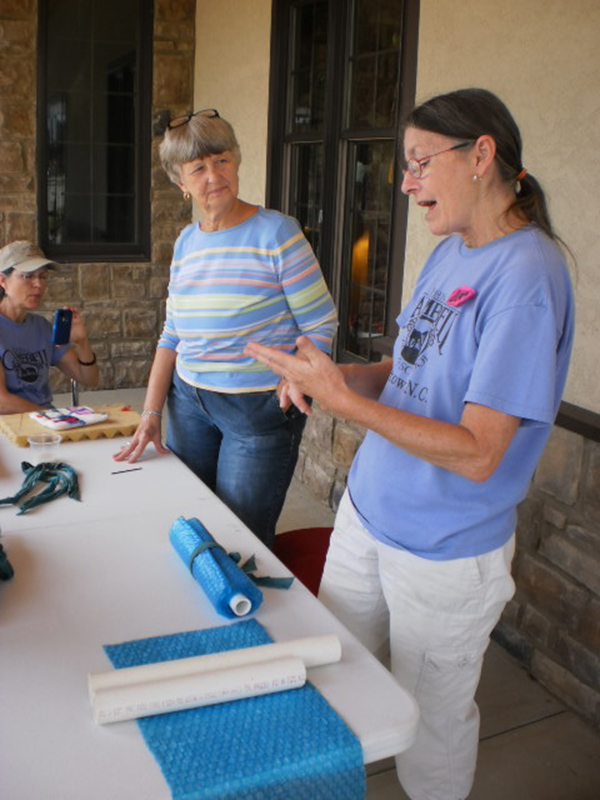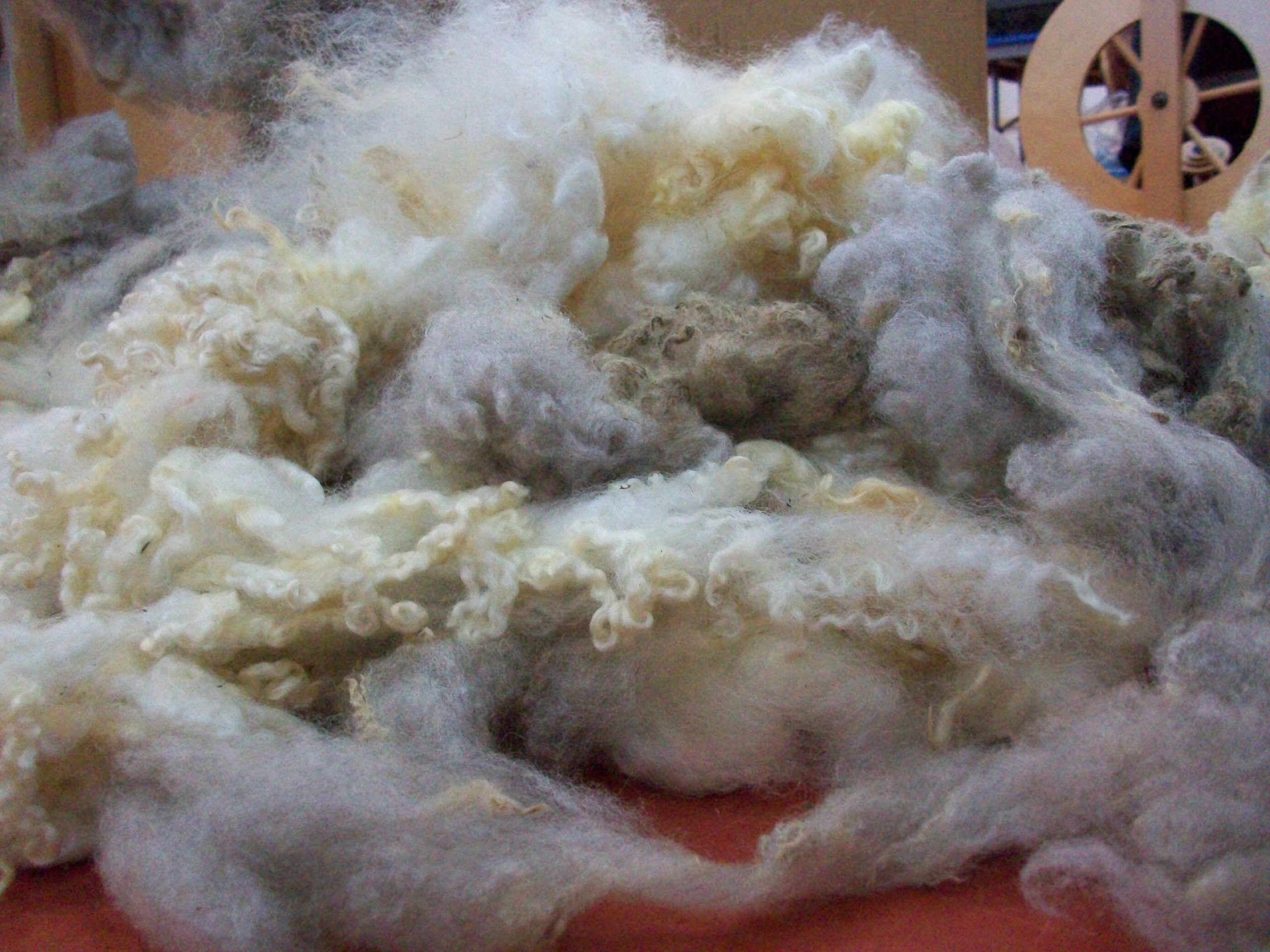I stopped by the Yarn Circle on a Monday afternoon to speak with Martha Owen, our beloved longtime Resident Artist in Spinning, Knitting, Dyeing and Felt Making. We talked about many things including fiber arts, raising sheep, travel, artistic process, Fair Isle, her rich history with the Folk School, and more. Enjoy our interview!
[caption id="attachment_10134" align="aligncenter" width="480"]
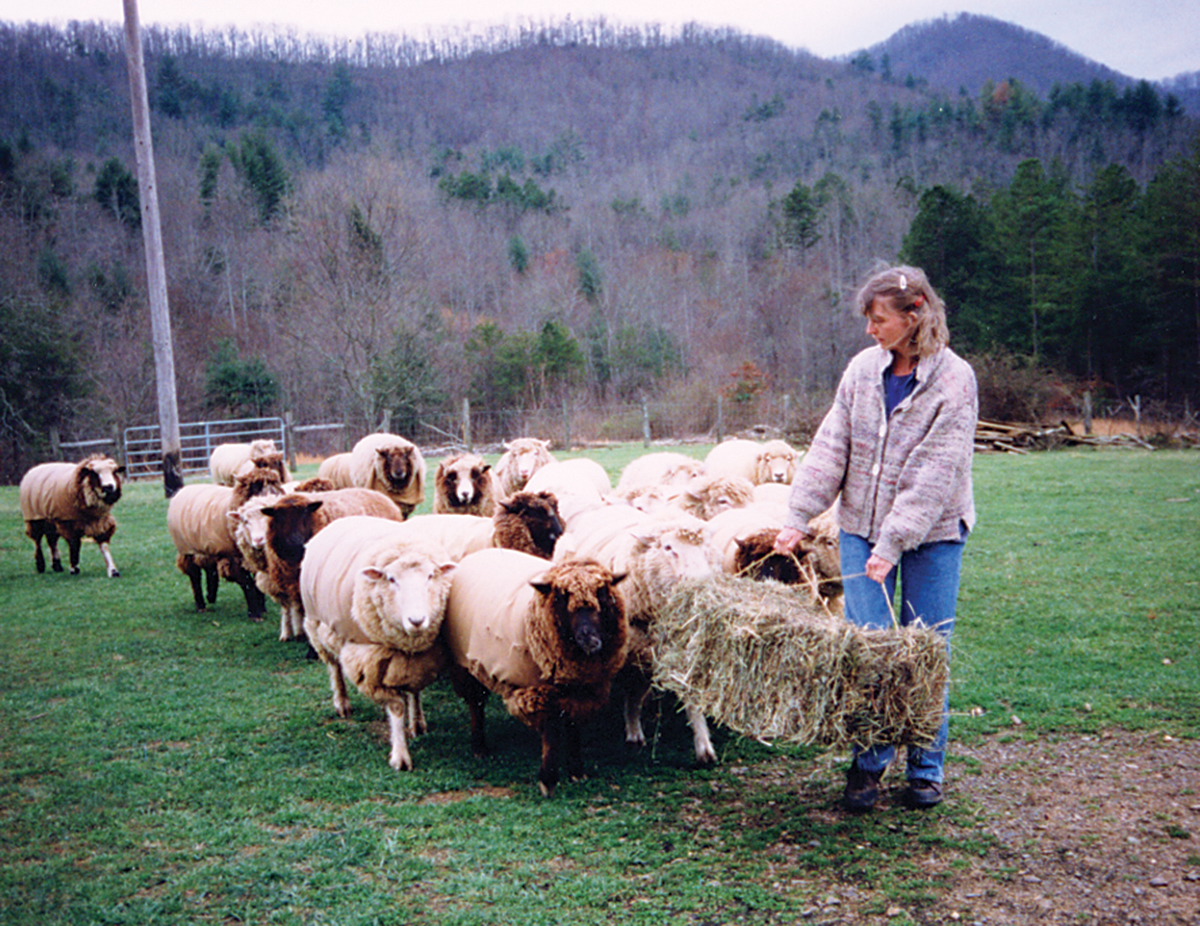
Don't ever lead your sheep with feed! A student photo op pic by Bonnie Shearer[/caption]
CP: How did you become involved with the Folk School?
MO: There was one year when I was a wee lass that I came to Little Folk School. I must have been 8, 9, or 10. I grew up in Pennsylvania, but my mother, Mary Porter Fain Owen came from Murphy. I would spend the summers here with my grandmother. At that time there was only one group of kids in Little Folk School. I learned to dance and I still sing the song I learned.
[caption id="attachment_10131" align="alignright" width="284"]
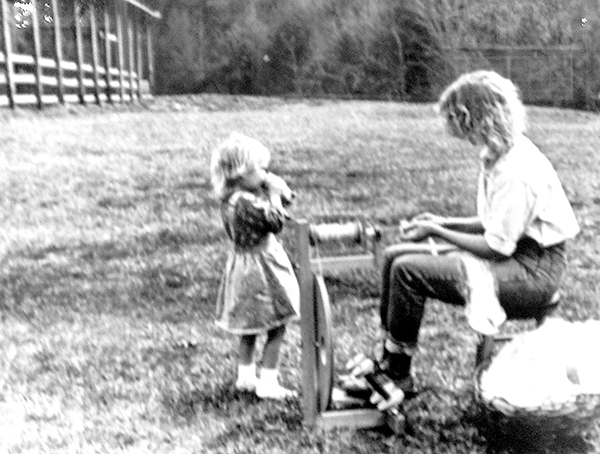
Photo shoot for Early American Life Magazine: Spinning near Festival Barn, August 1988 - That's Emolyn drinking a "grape coke" and trying to be good[/caption]
The next time, I was in college and I came for dancing again. I was doing volunteer work with a local church and we came to the dance one night. One summer my mother gave me a spinning wheel she had gotten from my great aunt and said: “Look! You always did like weird stuff.” She put the wheel down in front of me walked off and I thought “Well, I don’t know how to work with this thing.” My grandmother was reading the Cherokee Scout and saw an ad that the Campbell Folk School had a two-week class in Spinning and Dyeing. She said "Why don’t you go down and learn?" I said “Well, maybe I will.”
The full craft program that we have now had started in the '70s. The class was taught in Open House by Pam Strawn. We would card and spin and then do a dye pot when we had a pound of yarn between all of us. From that I made my first vest and I wore it for years to prove to my students that you should make something for any yarn you spin, you don’t have to wait until you spin “perfect” yarn.
My whole life turned left after taking that spinning class. That was 1978. I married my enabler, David Liden in 1979, and I had sheep by 1980.
CP: Tell me about your first sheep.
MO: I bought two ewes with lambs by their sides. One of the lambs was called "Maw Maw" and was the same age as my oldest daughter, Annie Fain. Maw Maw's portrait is hanging in our house. She was a pretty important sheep and I learned a lot of things from her. She lived to be 17.
CP: Do you have tips for beginning sheep owners?
[caption id="attachment_10141" align="alignleft" width="237"]
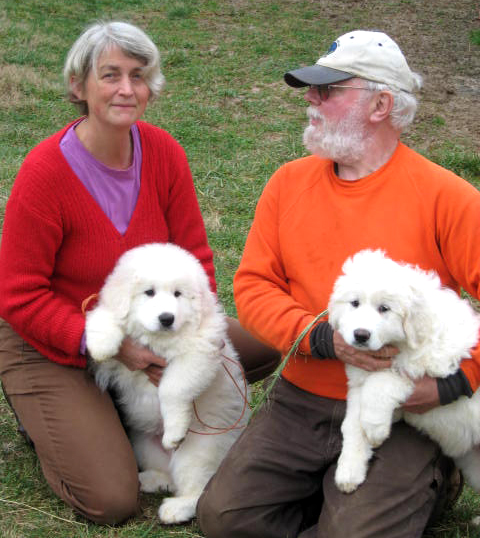
Ro-bear and Julliet, our current Great Pyrenees dogs - they weigh at least 125 pounds each now and live with the sheep (Oh, and Martha and David!) - Photo by Charlotte Crittenden[/caption]
MO: Now I have 35 sheep, but you've got to start small. Sheep reproduce quickly. While you are learning about things like housing, worming, and hoof trimming, etc, the fewer sheep the better. Security is also top priority. Sheep don’t have a way to protect themselves besides snorting, stomping, and running away which is very attractive to dogs. The biggest problems you have are neighbors' dogs and strays. Try security animals like llamas, donkeys, or Great Pyrenees. I have two Great Pyrenees right now. I haven't had any predator problems since they have been here. We are on our fourth generation. A border collie's job is the tell the sheep what to do, but the Pyrenees protect the sheep. They live with the sheep.
CP: As a current resident artist, one of your duties is to schedule teachers for the knitting, dyeing, felt making and spinning classes at the Folk School. How do you find them?
MO: Every possible way you can think of. We need someone who is passionate about what they do, someone who has done their craft a lot, but is a good teacher. I am always looking around and listening.
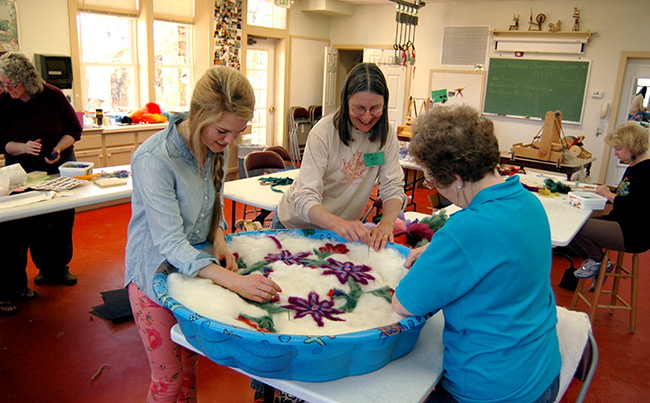 Felted Rug Class with Becky Walker in the Wet Room[/caption]
Felt is the oldest known fabric used by man. That stands to figure... felt is so easy to make, it was probably first discovered by accident. The recipe for felt, after all, is wool, moisture and agitation. Picture lining a sandal or shoe with raw wool to act as a cushion. Now picture walking around on that wool, smooshing it with every step, maybe sweating on it a bit to add the needed moisture. By the end of a long walk, you're not taking out bits of raw wool, but essentially a felted sock that fits your feet perfectly. While felting techniques have come a long way, that essential concept of felt making is still the same.
I sat down to talk with Becky Walker about her adventures with felt making. You've seen Becky around the Folk School campus wearing a knit hat, sweater or socks, or maybe on the dance floor wearing her felted name tag. Wherever you may meet Becky, her enthusiasm for her passions – music, dance, good food, good friends, animals and fiber – becomes clear right away. Let's meet her.
[caption id="attachment_12657" align="alignright" width="208"]
Felted Rug Class with Becky Walker in the Wet Room[/caption]
Felt is the oldest known fabric used by man. That stands to figure... felt is so easy to make, it was probably first discovered by accident. The recipe for felt, after all, is wool, moisture and agitation. Picture lining a sandal or shoe with raw wool to act as a cushion. Now picture walking around on that wool, smooshing it with every step, maybe sweating on it a bit to add the needed moisture. By the end of a long walk, you're not taking out bits of raw wool, but essentially a felted sock that fits your feet perfectly. While felting techniques have come a long way, that essential concept of felt making is still the same.
I sat down to talk with Becky Walker about her adventures with felt making. You've seen Becky around the Folk School campus wearing a knit hat, sweater or socks, or maybe on the dance floor wearing her felted name tag. Wherever you may meet Becky, her enthusiasm for her passions – music, dance, good food, good friends, animals and fiber – becomes clear right away. Let's meet her.
[caption id="attachment_12657" align="alignright" width="208"]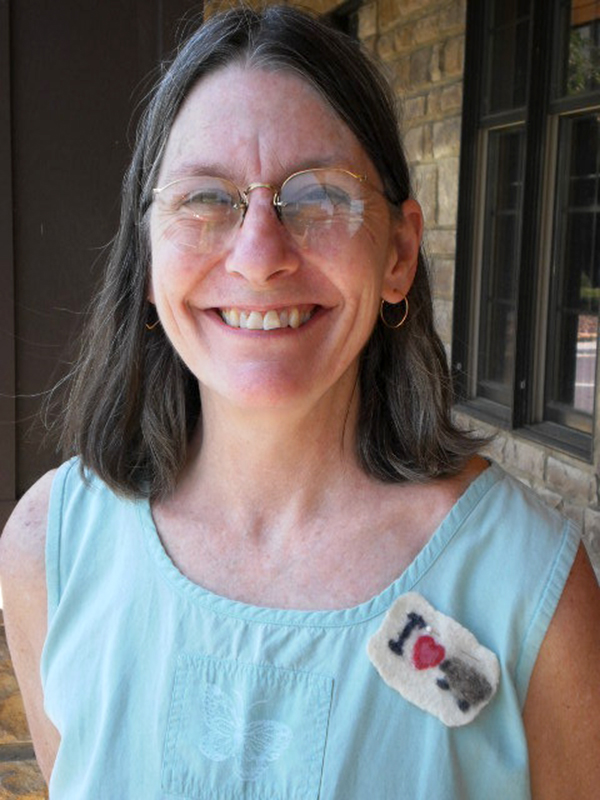 Becky and her felted name badge[/caption]
CC: How did you first become interested in becoming a fiber artist?
BW: Well, my mother taught me to knit when I was a real little kid, I was about seven. I've always loved animals, or anything with fur, anyway, and one thing lead to another. I've pretty much continued knitting through out my life so far. So I haven't knitted all my life yet (she laughs).
CC: How did you discover the Folk School?
BW: After I met Steve, my husband. He was a Folk School person and this was one of the first places we came. His son, Able lived over here, and he wanted me to meet Able and his mom. Of course we had to come dance because we were right here. Actually, I had encountered the Folk School in my early 20s in the book Handicrafts of the Southern Highlands. There was a chapter on the Folk School and I thought, “Wow, that seems like such a great place. I'd love to go there!” but didn't really think I ever would. So the fact that we came here right away was pretty neat, and I've been loving it ever since. It was a while before I got to take a class, so anyway, we'd come here to dance and see family.
CC: What kind of fiber arts do you do?
[caption id="attachment_12666" align="alignright" width="217"]
Becky and her felted name badge[/caption]
CC: How did you first become interested in becoming a fiber artist?
BW: Well, my mother taught me to knit when I was a real little kid, I was about seven. I've always loved animals, or anything with fur, anyway, and one thing lead to another. I've pretty much continued knitting through out my life so far. So I haven't knitted all my life yet (she laughs).
CC: How did you discover the Folk School?
BW: After I met Steve, my husband. He was a Folk School person and this was one of the first places we came. His son, Able lived over here, and he wanted me to meet Able and his mom. Of course we had to come dance because we were right here. Actually, I had encountered the Folk School in my early 20s in the book Handicrafts of the Southern Highlands. There was a chapter on the Folk School and I thought, “Wow, that seems like such a great place. I'd love to go there!” but didn't really think I ever would. So the fact that we came here right away was pretty neat, and I've been loving it ever since. It was a while before I got to take a class, so anyway, we'd come here to dance and see family.
CC: What kind of fiber arts do you do?
[caption id="attachment_12666" align="alignright" width="217"]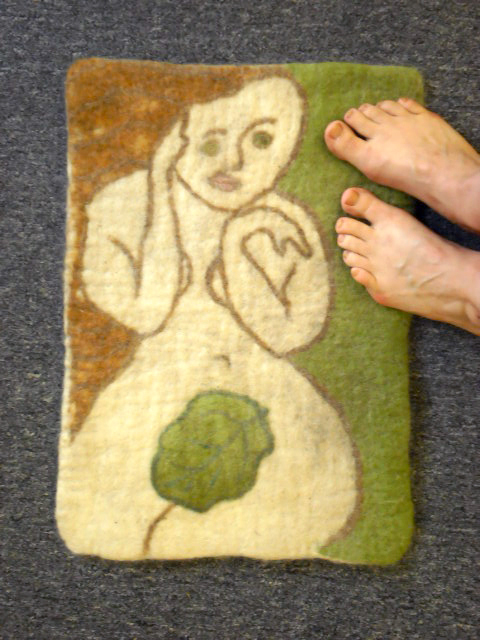 Felted Rug with Woman[/caption]
BW: Well, felt making is what I've become known for and I dabble a little bit with spinning. I'm not very good, but I just need to sit down at my wheel and do it more.
CC: Martha Owen, the Folk School Resident Artist in Knitting and Spinning, told me a story about teaching you to spin and you told her you might be more interested in felt making, right?
BW: I told her that I loved her, that I was interested in spinning, but I wasn't really ready to sit still yet. And so when I said that, she said “Well, you know, there's this thing called felt making and it's really active and I think you would like it. Carla is teaching a class here at the Folk School sometime coming up pretty soon and I think you should try that.” So I did.
Felted Rug with Woman[/caption]
BW: Well, felt making is what I've become known for and I dabble a little bit with spinning. I'm not very good, but I just need to sit down at my wheel and do it more.
CC: Martha Owen, the Folk School Resident Artist in Knitting and Spinning, told me a story about teaching you to spin and you told her you might be more interested in felt making, right?
BW: I told her that I loved her, that I was interested in spinning, but I wasn't really ready to sit still yet. And so when I said that, she said “Well, you know, there's this thing called felt making and it's really active and I think you would like it. Carla is teaching a class here at the Folk School sometime coming up pretty soon and I think you should try that.” So I did.




